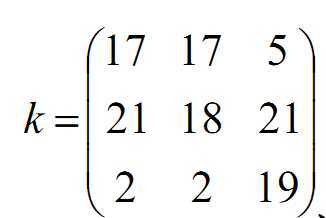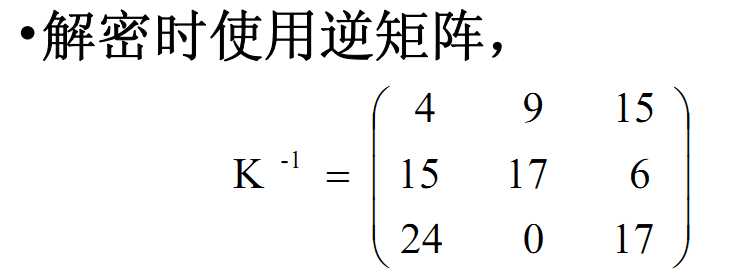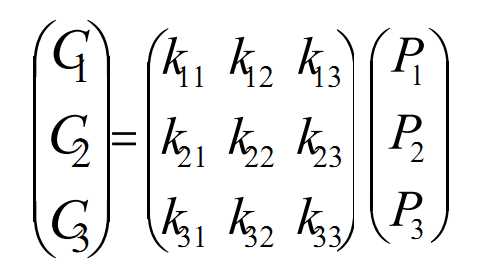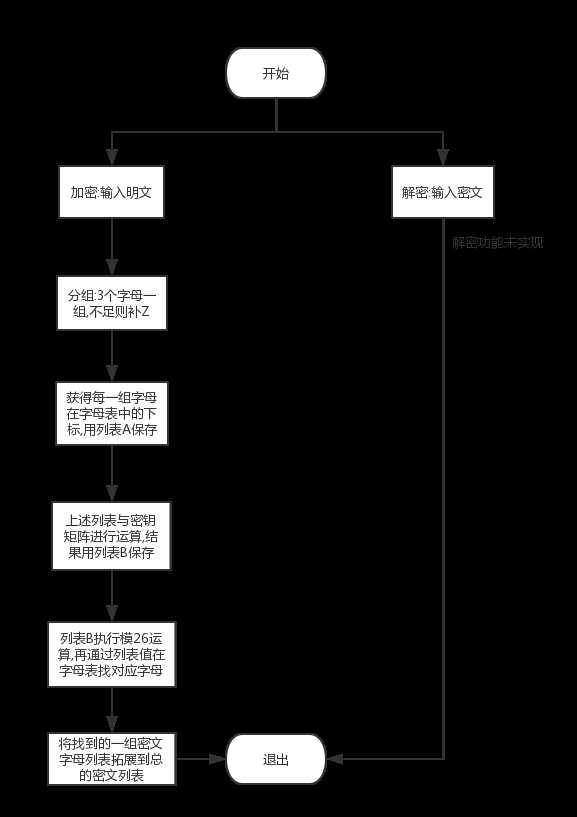信息安全-2:python之hill密码算法[原创]
Posted
tags:
篇首语:本文由小常识网(cha138.com)小编为大家整理,主要介绍了信息安全-2:python之hill密码算法[原创]相关的知识,希望对你有一定的参考价值。
前言:
hill密码算法我打算简要介绍就好,加密矩阵我用教材上的3*3矩阵,只做了加密,解密没有做,不过我觉得会加密就会解密的~~


一、hill算法原理
hill密码是一种多字母替代密码,由数学学Leste Hill于1929年研制成功。该密码算法取m个连续的明文字母,并用m个密文字母代替,用向量或矩阵表示为(这里取m=3,C和P是长度为3的列向量,K是3*3矩阵):

即:C=KP (C为密文,P为明文,K为密钥矩阵)
PS:加密操作要执行模26运算
二、加密规则
加密规则也不难的,就是有个矩阵运算(忘了可以谷哥一下,和线代有关~)
- 对明文进行分组,每3个字母一组,不足则字母Z(我设定的,下面编程也是补Z)
- 进行矩阵运算,对每组字母求密文
举例:
对pay more money进行加密,明文的前3个字母表示为:pay=(15 0 24)T
计算密文的过程:K(15 0 24)T=(375 819 486)Tmod 26=(11 13 18)T=LNS
依此类推,可得密文为LNS HDL EWM TRW
三、编程与思路
思路请看我画的流程图,网址http://processon.com/diagraming/583aff30e4b086d1e7d3b617

源代码

1 #加密密钥矩阵 2 K_LIST = [[17, 17, 5], 3 [21, 18, 21], 4 [2, 2, 19]] 5 6 #26个字母列表:方便找出对应下标 7 ALPHABET = ["A","B","C","D","E","F","G", 8 "H","I","J","K","L","M","N", 9 "O","P","Q","R","S","T","U", 10 "V","W","X","Y","Z"] 11 12 13 def get_index(alphabet): 14 """ 15 获得字母在字母表中的对应位置(下标) 16 :param alphabet: 明文字母 17 :return: 下标 18 """ 19 alphabet = alphabet.upper() 20 return ALPHABET.index(alphabet) 21 22 23 def deal_index(list_index): 24 """ 25 加密处理C=KP 26 :param list_index: 每一组明文字母的下标 27 :return: 加密后密文的下标 28 """ 29 deal_list = [0,0,0] 30 for i in range(len(K_LIST)): 31 for j in range(len(K_LIST[i])): 32 deal_list[i] += list_index[j] * K_LIST[i][j] 33 deal_list[i] = (deal_list[i] % 26) 34 return deal_list 35 36 37 def get_alphabet(deal_list): 38 """ 39 通过字母的下标获得对应字母 40 :param deal_list: 下标的列表 41 :return: 返回密文字母列表 42 """ 43 cipher_list = [] 44 for i in deal_list: 45 cipher_list.append(ALPHABET[i]) 46 return cipher_list 47 48 49 def encryption(clear_text): 50 """ 51 加密时调用的函数 52 :param clear_text:输入的明文 53 :return: 加密后的密文 54 """ 55 list_clear_text = list(clear_text.strip().replace(" ", "")) 56 print(list_clear_text) 57 #明文每3个一组,不足则补充字母Z 58 for i in range(len(list_clear_text)): 59 if i % 3 == 0 and i+2 > len(list_clear_text)-1: # 越界,则需在最后一组不足3个补字母Z 60 if i+1 > len(list_clear_text)-1: 61 list_clear_text.insert(i + 1, "Z") 62 list_clear_text.insert(i + 2, "Z") 63 print(list_clear_text) 64 cipher_list = [] #用来存入密文 65 #明文每3个为一组,找出每组在字母表中的位置(用一个列表来保存) 66 for i in range(len(list_clear_text)): 67 if i % 3 == 0 and i+2 <= len(list_clear_text)-1: 68 x = get_index(list_clear_text[i]) 69 y = get_index(list_clear_text[i+1]) 70 z = get_index(list_clear_text[i+2]) 71 list_index = [x, y, z] 72 print(list_index) 73 #调用deal_inde函数进行加密 矩阵K与明文P运算得到密文C,即C=KP 74 deal_list = deal_index(list_index) 75 #print(deal_list) #测试用的 76 part_cipher_list = get_alphabet(deal_list) #返回一组密文 77 cipher_list.extend(part_cipher_list) 78 #print(part_cipher_list) #测试用的 79 80 print(cipher_list) 81 return "".join(cipher_list) 82 83 84 def decryption(): 85 print("解密未实现...") 86 87 88 if __name__ == "__main__": 89 while True: 90 choice = input("Please input E for encryption or D for decryption:") 91 if choice == "E": 92 clear_text = input("请输入明文:") 93 print("加密成功!密文:%s" % encryption(clear_text)) 94 if choice == "D": 95 cipher_text = input("请输入密文:") 96 decryption()
测试

1 Please input E for encryption or D for decryption:E 2 请输入明文:pay more money 3 [‘p‘, ‘a‘, ‘y‘, ‘m‘, ‘o‘, ‘r‘, ‘e‘, ‘m‘, ‘o‘, ‘n‘, ‘e‘, ‘y‘] 4 [‘p‘, ‘a‘, ‘y‘, ‘m‘, ‘o‘, ‘r‘, ‘e‘, ‘m‘, ‘o‘, ‘n‘, ‘e‘, ‘y‘] 5 [15, 0, 24] 6 [12, 14, 17] 7 [4, 12, 14] 8 [13, 4, 24] 9 [‘L‘, ‘N‘, ‘S‘, ‘H‘, ‘D‘, ‘L‘, ‘E‘, ‘W‘, ‘M‘, ‘T‘, ‘R‘, ‘W‘] 10 加密成功!密文:LNSHDLEWMTRW 11 Please input E for encryption or D for decryption:payp 12 Please input E for encryption or D for decryption:E 13 请输入明文:payy 14 [‘p‘, ‘a‘, ‘y‘, ‘y‘] 15 [‘p‘, ‘a‘, ‘y‘, ‘y‘, ‘Z‘, ‘Z‘] 16 [15, 0, 24] 17 [24, 25, 25] 18 [‘L‘, ‘N‘, ‘S‘, ‘W‘, ‘X‘, ‘B‘] 19 加密成功!密文:LNSWXB 20 Please input E for encryption or D for decryption:D 21 请输入密文:LNSWXB 22 解密未实现... 23 Please input E for encryption or D for decryption:
以上是关于信息安全-2:python之hill密码算法[原创]的主要内容,如果未能解决你的问题,请参考以下文章
信息安全-1:python之playfair密码算法详解[原创]
